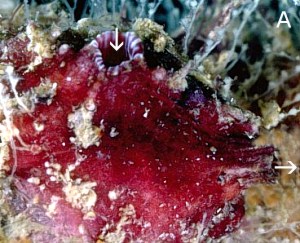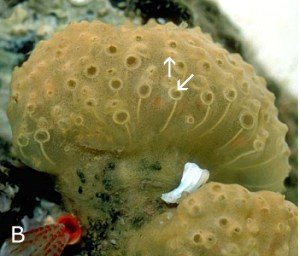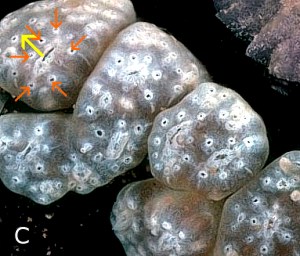
Ascidians (Sea squirts, Tunicates)
PHOTO
A, Coffs Harbour, northern New South Wales, Australia. December 1980. 5cm long. B, Long Reef, Syney, N.S.W., Australia. December 1995. 4cm long. C, Arrawarra, Coffs Harbour area, northern New South Wales, Australia. Width of photo - 35mm. In all cases the arrows show the direction of the water currents. PHOTOS: Bill Rudman.
Although they are soft and boneless, ascidians are not invertebrates, but primitive chordates, the phylum to which all back-boned animals belong. This evolutionary relationship to back-boned animals can only be seen in their small short-lived tadpole-like larvae which swim for just a few hours before settling to grow into an adult firmly attached to a rock or weed. Ascidians are filter feeders. Inside their sac-like outer skin there is a seive-like 'branchial basket' which filters microscopic food particles out of the seawater. Fresh seawater is drawn into the branchial basket through the inhalent siphon and filtered seawater and waste material is ejected through an exhalent siphon.
Solitary ascidians have a tough leathery outer skin (tunic) which is why they are sometimes called tunicates. The common name Sea Squirt, arises from their habit of squirting a jet of water, when you stand on or near them when they are uncovered at low tide.
Most solitary ascidians are attached either along one side of their bodies or at the base, but their are some species which are attached by stalks, sometimes 2 or 3 times their body length. Many ascidians form colonies. In the intertidal zone, many of the fleshy, brightly coloured patches under rocks or in shaded crevices are ascidian colonies.
PHOTO A is of a solitary ascidian showing the inhalent and exhalent siphons. PHOTO B is a colonial species in which each individual animal (zooid) retains its exhalent siphon. PHOTO C shows a colony in which zooids are packed in a ring and share a centrally placed common exhalent siphon (yellow arrow).
Ascidians are an important food source for some nudibranchs. Species of Goniodoris, such as G. meracula, and Nembrotha, such as N. kubaryana, feed on specific ascidian species.


Rudman, W.B., 2000 (May 25) Ascidians (Sea squirts, Tunicates). [In] Sea Slug Forum. Australian Museum, Sydney. Available from http://www.seaslugforum.net/factsheet/ascidian
